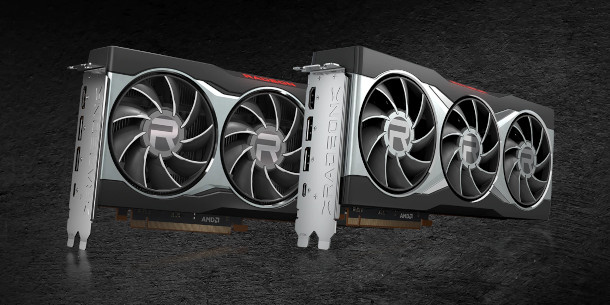AMD unveils Radeon RX 6000 Series GPUs

AMD has unveiled the Radeon RX 6900 XT, the Radeon RX 6800 XT and the Radeon RX 6800: the first three GPUs in its new Radeon RX 6000 Series of gaming cards, based on its new RDNA 2 architecture.
The firm is positioning the three ‘Big Navi’ cards, which are due to ship worldwide in November and December, as direct competitors to Nvidia’s current GeForce RTX 30 Series of Ampere-based GPUs.

Although we don’t traditionally cover gaming GPUs on CG Channel, the new RX 6000 Series cards have a number of features interesting for CG artists: notably, dedicated ray tracing accelerator cores.
How do the key specs compare to Nvidia’s current GeForce RTX GPUs?
Above, you can see key specs for the new cards, and one of their predecessors: 2019’s RX 5700 XT.
In its own benchmarks, AMD compares the Radeon RX 6900 XT to Nvidia’s GeForce RTX 3090, the RX 6800 XT to the RTX 3080, and the RX 6800 to the last-gen RTX 2080 Ti, standing in for the unreleased RTX 3070.
In terms of core specs, the Radeon RX 6000 Series cards trade blows with the Nvidia RTX 30 Series cards they are pitched against, offering higher boost clock speeds but lower FP32 compute performance.
Both price and power consumption, in the form of Total Board Power (TBP), are in AMD’s favour in the case of the two higher-end pairs of cards; in Nvidia’s favour for the Radeon RX 6800 and GeForce RTX 3070.
And at 16GB apiece, the on-board memory capacity of the Radeon RX 6000 Series cards is lower than that of the GeForce RTX 3090, but higher than that of the GeForce RTX 3080 and 3070.
New dedicated Ray Accelerators for GPU ray tracing – in game-like renderers, at least
We won’t go into the details of the Radeon RX 6000 Series cards’ new RDNA 2 architecture here. (If you’re interested, Anandtech has a thorough analysis.)
However, it has one feature of particular interest to CG artists: like Nvidia’s RTX cards, but unlike AMD’s previous Radeon RX GPUs, the RX 6000 Series feature dedicated ray tracing cores.
Each of the cards’ compute units now comes with a “high performance, fixed-function Ray Accelerator engine” for hardware-accelerated ray tracing, analogous to the RT cores on Nvidia RTX cards.
Software can access the Ray Accelerators via DirectX 12’s DXR (DirectX Raytracing) API.
While DXR is used to accelerate ray tracing in games – and in game engines commonly used for CG work, including Unreal Engine and Unity – it’s less widely used by traditional DCC applications.
Currently, most offline renderers that support hardware-accelerated ray tracing access the RT cores on RTX cards via Nvidia’s own OptiX API, as is the case with V-Ray and Blender’s Cycles renderer.
As a result, unless you use Unreal Engine for rendering, you’re unlikely to be able to make use of AMD’s new Ray Accelerators to speed up your CG work when the Radeon RX 6000 Series cards first ship.
It will be interesting to see whether more DCC applications start to support DXR for GPU ray tracing in future.
One interesting part of AMD’s strategy here is FidelityFX, an open-source developer toolkit for implementing hybrid rendering pipelines by selectively adding ray traced effects to rasterised renders.
Although it’s pitched primarily at game devs, it’s also the approach that AMD has been taking in its own DCC tools, including the ‘full spectrum rendering‘ system in its Radeon ProRender renderer.
Pricing and shipping dates
AMD’s RX 6800 and Radeon RX 6800 XT should become available worldwide on 18 November 2020, with recommended prices of $579 and $649.
The RX 6900 XT should follow on 8 December 2020 with a recommended price of $999.
Source:Jim Chacker/CG Channel

熱門頭條新聞
- The Ministry of Education encourages the inclusion of artificial intelligence education in local and school-based curricula.
- The OpenHarmony 5.0 Release version has been officially released.
- China’s Minidramas Make Big Splash
- DevGAMM Lisbon 2024 celebrates another successful edition with more than 750 attendees from around the world
- Wait What’s That – A VRy Unique Take On A Classic Drawing Game – Out Now For Free On Meta Quest!
- Slow-Motion Collapse: How Nostalgia, Streaming, and Short-Sightedness Undermined Hollywood’s Future
- PBS NOVA / GBH JOINS THE PRODUCTION OF ZED AND ARTE’S PREMIUM DOCUMENTARY THE LOST TOMBS OF NOTRE-DAME
- Biopunk Action Title Sonokuni Launching Early 2025
